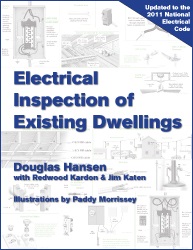This question came up during a conversation that I was having with another home inspector during the last ASHI chapter meeting. We know that the covers for electrical boxes need to be accessible, but what if the box is located in an attic? Is it acceptable to bury the box in insulation? I said I’d research this info and get back to him, but I thought this might make for a good, short blog post topic. Also, I happened across a great photo of a junction box buried by vermiculite insulation while looking through old photos for last week’s blog post on vermiculite insulation.
As I’ve mentioned in past blog posts, I hate having to look up anything in the National Electrical Code (NEC). I don’t use that book enough to know exactly where to find what I’m looking for, so I rely on other books to tell me where to look. My first go-to book is typically Code Check Electrical, which is extremely well laid out and easy to use. I prefer the pdf version of this book because I can use word searches. A quick check there led me to section 314.29 of the 2014 NEC, which states the following:
314.29 Boxes, Conduit Bodies, and Handhole Enclosures to Be Accessible. Boxes, conduit bodies, and handhole enclosures shall be installed so that the wiring contained in them can be rendered accessible without removing any part of the building or structure or, in underground circuits, without excavating sidewalks, paving, earth, or other substance that is to be used to establish the finished grade.
 So that begs the question: is insulation part of the building or structure? Common sense says that insulation is part of the building, so it seems that maybe boxes shouldn’t be buried there. Electrical boxes being buried in insulation aren’t specifically discussed in the NEC, so I turned to my second book, Electrical Inspections of Existing Dwellings, courtesy of the same folks at Code Check. Not only does this book have a lot of commentary and history of the electrical codes, but it’s written for home inspectors. It’s a book that every home inspector should have in their library.
So that begs the question: is insulation part of the building or structure? Common sense says that insulation is part of the building, so it seems that maybe boxes shouldn’t be buried there. Electrical boxes being buried in insulation aren’t specifically discussed in the NEC, so I turned to my second book, Electrical Inspections of Existing Dwellings, courtesy of the same folks at Code Check. Not only does this book have a lot of commentary and history of the electrical codes, but it’s written for home inspectors. It’s a book that every home inspector should have in their library.
This book had the exact reference I was looking for, saying this about electrical boxes:
“They can be buried inside insulation provided it can be removed to access the box. Foamed-in-place insulation should not cover a box.”
Perfect. That’s exactly what I was looking for. I also contacted the folks at Code Check to ask for further commentary on this matter. They told me to look up the NEC definition of “Accessible (as applied to wiring methods)”:
“Capable of being removed or exposed without damaging the building structure or finish or not permanently closed in by the structure or finish of the building.”
I’d say that fits the bill quite nicely. Local interpretations may vary.

Paul
May 3, 2016, 11:56 am
“Capable of being removed or exposed without damaging the building structure or finish or not permanently closed in by the structure or finish of the building.”
So that would seem to me that boxes behind walls or above finished ceilings would not qualify as code, since you would need to remove a wall or ceiling to access it. A box buried in loose insulation would seem even more ideal. So how does this address behind wall?
Reuben Saltzman
May 3, 2016, 3:55 pm
Hi Paul,
You’re correct, if a box is completely buried behind a wall, it would not be a proper installation. If a box is installed in a wall, the cover needs to remain accessible.
Matthew Anderson
May 3, 2016, 5:37 pm
Nice find, I was leaning towards it being acceptable when you referenced it in the last post. I however, was not nearly as motivated as you were to investigate this. Thanks for allowing me to be a bit lazy 🙂
Good information, thank you!
Dave Miller
May 6, 2016, 9:48 am
Nice post Reuben! But, my favorite part is picturing you making the “Junction Box” sign for your pic! 🙂 Great info on the blog – keep em coming!
Charlie
June 27, 2016, 12:48 pm
Note that a ceiling box, being accessible from below the ceiling, can be buried in foam insulation, and in fact that’s a useful thing to do to prevent air leakage through the ceiling plane.